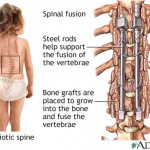Surgery or operative management is usually performed on severe scoliotic deformities – those which exceed a Cobb angle of 45 degrees, and when it has not been possible to halt scoliosis progression by conservative means. In some cases surgery is necessary when treatment with physiotherapy and bracing has not succeeded in stopping progression. (This is 10% of all cases, if treatment is applied according to recommended indications). But most often these are the cases where the only treatment has been ‘wait and observe’ while scoliosis has continued to progress, and a corrective brace has not been prescribed when the Cobb angle has reached 20-25 degrees. Even in such cases you should talk with the surgeon and conservative treatment specialists, whether physiotherapy and bracing could still be applied to ensure a better presurgical position of the spine or to avoid an operation altogether.
To learn more on when surgery is indicated, please see section on ‘indications for surgery’.
The goal of surgery is to reduce spinal curvature and create a cosmetic improvement and, sometimes, to reduce pain. The vertebrae of a curve are forced in a corrected position and fused, using rods , screws and bone grafts for fixation.
To ensure spinal balance, several rods are used. The biggest drawback of treating scoliosis with surgery is that it halts spinal growth. For this reason the operation is preferably performed at an age when only minimal spinal growth is to be expected. Fusing a curve with rods means immoblilizing this part of the spine and overloading the adjacent free segments.
The advantage of surgical treatment is getting results in a relatively short period of time without the burden of regularly performing physiotherapy or wearing a brace. However, it has to be clear that surgery means living with spinal implants life-long.
Surgical methods have clearly improved over time. Corrections have become more effective, and recuperating times from the operation have been getting shorter. Nevertheless, do not underestimate the complexity of surgical intervention: the operation is performed in close proximity to the spinal canal and complications are possible.


